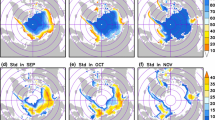Abstract
Associations between the autumn Arctic sea ice concentration (SIC) and Asian winter temperature are discussed using the singular value decomposition analysis. Results show that in recent 33 years reduced autumn Arctic sea ice is accompanied by Asian winter temperature decrease except in the Tibetan plateau and the Arctic Ocean and the North Pacific Ocean coast. The autumn SIC reduction excites two geopotential height centers in Eurasia and the north Arctic Ocean, which are persistent from autumn to winter. The negative center is in Barents Sea/Kara Sea. The positive center is located in Mongolia. The anomalous winds are associated with geopotential height centers, providing favorable clod air for the Asian winter temperature decreasing in recent 33 years. This relationship indicates a potential long-term outlook for the Asian winter temperature decrease as the decline of the autumn sea ice in the Arctic Ocean is expected to continue as climate warms.
Similar content being viewed by others
References
Alexander M, Bhatt U S, Walsh J E, et al. 2004. The atmospheric response to realistic Arctic sea ice anomalies in an AGCM during winter. Journal of Climate, 17(5): 890–905
Arzel O, Fichefet T, Goosse H. 2006. Sea ice evolution over the 20th and 21st centuries as simulated by current AOGCMs. Ocean Modelling, 12(3–4): 401–415
Blanchard-Wrigglesworth E, Armour K C, Bitz C M, et al. 2011. Persistence and inherent predictability of Arctic sea ice in a GCM ensemble and observations. Journal of Climate, 24(1): 231–250
Bretherton C S, Smith C, Wallace J M. 1992. An intercomparison of methods for finding coupled patterns in climate data. Journal of Climate, 5(6): 541–560
Deser C, Walsh J E, Timlin M S. 2000. Arctic sea ice variability in the context of recent atmospheric circulation trends. Journal of Climate, 13(3): 617–633
Deser C, Magnusdottir G, Saravanan R, et al. 2004. The effects of North Atlantic SST and sea ice anomalies on the winter circulation in CCM3. Part II: Direct and indirect components of the response. Journal of Climate, 17(5): 877–889
DeWeaver E T, Bitz C M, Tremblay L B. 2008. Arctic Sea Ice Decline: Observations, Projections, Mechanisms, and Implications. Washington DC: American Geophysical Union
Ghatak D, Frei A, Gong G, et al. 2010. On the emergence of an Arctic amplification signal in terrestrial Arctic snow extent. Journal of Geophysical Research: Atmospheres (1984–2012), 115(D24): doi: 10.1029/2010JD014007
Holland M M, Bitz C M, Tremblay B. 2006. Future abrupt reductions in the Summer Arctic sea ice. Geophysical Research Letters, 33(23): 1–5
Honda M, Yamazaki K, Tachibana Y, et al. 1996. Influence of Okhotsk sea-ice extent on atmospheric circulation. Geophysical Research Letters, 23(24): 3595–3598
Honda M, Inoue J, Yamane S. 2009. Influence of low Arctic sea-ice minima on anomalously cold Eurasian winters. Geophysical Research Letters, 36(8): doi: 10.1029/2008GL037079
Intergovernmental Panel on Climate Change. 2007. Climate Change 2007: The Physical Science Basis: Working Group I Contribution to the Fourth Assessment Report of the IPCC. Cambridge, UK: Cambridge University Press
Kanamitsu M, Ebisuzaki W, Woollen J, et al. 2002. NCEP-DOE AMIP-II reanalysis (R-2). Bulletin of the American Meteorological Society, 83(1): 1631–1643
Kumar A, Perlwitz J, Eischeid J, et al. 2010. Contribution of sea ice loss to Arctic amplification. Geophysical Research Letters, 37(21): doi: 10.1029/2010GL045022
Liu Jiping, Curry J A, Wang Huijun, et al. 2012. Impact of declining Arctic sea ice on winter snowfall. Proceedings of the National Academy of Sciences of the United States of America, 109(11): 4074–4079
Liu Na, Lin Li Na, Kong Bin, et al. 2016. Association between Arctic autumn sea ice concentration and early winter precipitation in China. Acta Oceanologica Sinica, 35(5): 73–78
Magnusdottir G, Deser C, Saravanan R. 2004. The effects of North Atlantic SST and sea ice anomalies on the winter circulation in CCM3. Part I: Main features and storm track characteristics of the response. Journal of Climate, 17(5): 857–876
Rigor I G, Wallace J M, Colony R L. 2002. Response of sea ice to the Arctic Oscillation. Journal of Climate, 15(8): 2648–2663
Serreze M C, Holland M M, Stroeve J. 2007. Perspectives on the Arctic’s shrinking sea-ice cover. Science, 315(5818): 1533–1536
Singarayer J S, Bamber J L, Valdes P J. 2006. Twenty-first-century climate impacts from a declining Arctic sea ice cover. Journal of Climate, 19(7): 1109–1125
Stroeve J, Holland M M, Meier W, et al. 2007. Arctic sea ice decline: Faster than forecast. Geophysical Research Letters, 34(9): doi: 10.1029/2007GL029703
Symon C, Arris L, Heal B. 2004. Arctic Climate Impact Assessment. Cambridge: Cambridge University Press
Wang Muyin, Overland J E. 2009. A sea ice free summer Arctic within 30 years?. Geophysical Research Letters, 36(7), doi: 10.1029/2009GL037820
World Meteorological Organization. 2009. WMO Statement on the Status of the Global Climate in 2008, WMO-No.1039. Geneva: World Meteorological Organization
World Meteorological Organization. 2010. WMO Statement on the Status of the Global Climate in 2009, WMO-No.1055. Geneva: World Meteorological Organization
World Meteorological Organization. 2011. WMO Statement on the Status of the Global Climate in 2010, WMO-No.1074. Geneva: World Meteorological Organization
Author information
Authors and Affiliations
Corresponding author
Additional information
Foundation item: The Basic Research Operating Funds of First Institute of Oceanography, State Oceanic Administration under contract No. 2014T02 and 2014G02; the Chinese Polar Environment Comprehensive Investigation and Assessment Programmes, State Oceanic Administration under contract Nos CHINARE2015-03-01 and CHINARE2015-04-03; the Public science and Technology Research Funds Projects of Ocean under contract No. 201205007.
Rights and permissions
About this article
Cite this article
Liu, N., Lin, L., Wang, Y. et al. Arctic autumn sea ice decline and Asian winter temperature anomaly. Acta Oceanol. Sin. 35, 36–41 (2016). https://doi.org/10.1007/s13131-016-0911-0
Received:
Accepted:
Published:
Issue Date:
DOI: https://doi.org/10.1007/s13131-016-0911-0



